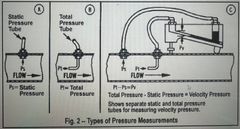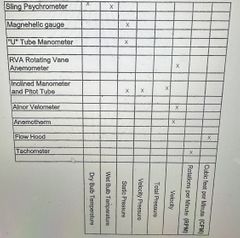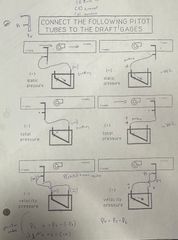![]()
![]()
![]()
Use LEFT and RIGHT arrow keys to navigate between flashcards;
Use UP and DOWN arrow keys to flip the card;
H to show hint;
A reads text to speech;
22 Cards in this Set
- Front
- Back
|
Anemotherm(hot wire anemeter) What does it measure? |
Air velocity in FPM Change or resistance of a heated wire |
|
|
Flow Hood (Balometer) What does it measure? |
Measures air volume Cubic feet per minute |
|
|
Pitot tube (or manometer) What does it measure? |
Measures Total Pressure and Static Pressure Then it finds velocity pressure Tp-Sp=Vp =Velocity pressure
Squareroot(Vp) x 4005 = FPM |
|
|
How do you use a manometer to get Velocity pressure? |

Pt= tube pointing toward airflow Ps= directly connected with no tube Pv=Pt-Ps |
|
|
Rotating Vane Anemometre What does it measure? |
Velocity fpm Can be used for grills or open ducts |
|
|
Sling Psychrometer?
What does it measure? |
Wetbulb or dry bulb Rotate at 180 rpm Use only distilled water |
|
|
Tachometer |
Used to measure shaft speed (RPM) |
|
|
Magnehelic gauge Or “U” tube manometer |
Measures static pressure in inches of water column. Ofter used for static pressure or pressure differential |
|
|
Velometer |
Measures velocity in FPM From grills, diffuser, or open duct work |
|
|
Quick sheet for all instruments and what they study |

Back (Definition) |
|
|
How to use manometer to find Velocity Pressure (Vp) |
Positive pressure side of furnace: Measure=P(total) and P(static) Total pressure= +0.9”W.C. Static pressure= +0.6”W.C —————————————- Velocity pressure= +0.3”W.C Negative pressure side of furnace: Measure=P(total) and P(static) Total pressure= -0.22”W.C. Static pressure= -0.66”W.C —————————————- Velocity pressure= +0.3”W.C |
|
|
A system with high static pressure is very restrictive. |
True, you want as much velocity pressure as possible |
|
|
Down stream means what? |
Down stream of the furnace filter is the fan section. Down stream of the fan section is the heat exchanger |
|
|
You have a Velocity Pressure of 0.03inWC and an area of 12in x 18in What is your volume circulated? |
4005 x root(0.03) = 693 ft/min
12in x 18in = 216 in^2 =216 in^2 x ( 1 ft^2 / 144 in^2) =1.5 ft^2 (693 ft/min)(1.5ft^2) =1040.55 CFM |
|
|
You have a Velocity Pressure of 0.06inWC and an area of 8” round. What is your volume circulated? |
4005 x root(0.06) = 981 ft/min Area= (pi)(r)^2 =(3.14)(4in)^2 = 50.24 in^2 =(50.24 in^2)(1 ft^2 / 144 in^2) =0.35 ft^2 (981 ft/min)(0.35ft^2) =343.3 CFM |
|
|
If you are measuring with a pitot tube on the negative side of a furnace. Static pressure is greater or smaller than total pressure? |
Static pressure is greater than total pressure Static -0.6 Total -0.3 Velocity pressure -0.3 - (-0.6) = 0.3 Velocity pressure is always positive. Velocity Pressure = P(t) - P(s) |
|
|
When you are measuring with a pitot tube on the positive side of the furnace is the static pressure greater or lower than total pressure? |
Total pressure is higher than static pressure in the positive side of the duct. |
|
|
What is the maximum total external system pressure that is a mid efficient? Or a high efficient? |
0.5 inWC max (mid efficient) 0.8 inWC max (high efficient) |
|
|
How do you wire up a pitot tube and inclined manometer |

Back (Definition) |
|
|
How to complete a duct traverse (pg.6) |
Make sure the place you are reading the static and total pressure is about 6 to 10 duct diameters downstream from any elbows. |
|
|
Rectangle traverse? Amount of readings? |
Minimum of 12 and max of 64 readings
If less than 64 readings are taken on any duct, the distance between the readings should not be over 6 inches. |
|
|
When you are measuring with a pitot tube do you point the tip into the airflow or pointing away from the airflow? |
You point the tip into the airflow. Note: static is measured off the side and total pressure is measured from the bottom. |

